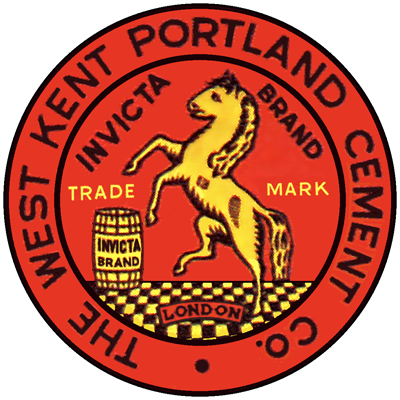
West Kent Invicta Brand.
Location:
- Grid reference: TQ71296234
- x=571290
- y=162340
- 51°20'4"N; 0°27'32"E
- Civil Parish: Burham, Kent
Clinker manufacture operational: 1877-1915, 1919-24/12/1925
Approximate total clinker production: 1.92 million tonnes
Raw Material: Initially Grey Chalk (Zig-zag Chalk Formation by gravity tramway from quarry at 572300,162400: 94-97 Ma) and Medway Alluvial Clay. As Chalk Marl (West Melbury Marly Chalk Formation: 97-100 Ma) was exposed, this progressively replaced the alluvium. After the war, slurry was supplied by Peters.
Ownership:
- 1877?-1885? West Kent Gault Brick and Cement Co. Ltd
- 1885?-1911 West Kent Portland Cement Co. Ltd
- 1911-1926 BPCM (Blue Circle)
Also known as Millbay Works, Margett’s and (confusingly) Burham Works (to distinguish it from the company’s Aylesford plant). Hydraulic lime had been made at the site from an early date, and by 1869 there were thirteen lime kilns. Chalk was shipped to the Aylesford plant. Bricks were made at both this and the Aylesford site, but it was not until 1877 that Portland cement production began, with eight chamber kilns making 163 t/week. The chamber kiln block was extended westwards with two (47 t/week) in 1881, two (51 t/week) in 1888, then ten (289 t/week) in 1893, and a final four (135 t/week) in 1899, bringing output to 685 t/week. The company was part of the APCM amalgamation in 1900, but dropped out and took an aggressively competitive position in the following decade. Two rotary kilns were added in 1905, and a third in 1907. These appear to have been similar to those described at Southam. Davis’ 1907 capacity of 1250 t/week appears to exclude kiln A3 which was installed in 1907. A fourth kiln was already being installed at the time of the BPCM takeover, and the chamber kilns were decommissioned at this time. The plant’s operations were combined with the adjacent Peters by BPCM. The plant was closed during 1916-1918. The plant was described in detail in the BPCM 1924 schedule. Run during the brief boom of the early 1920s, the plant was closed in 1925 for Portland production, although it continued for a year in a pilot experiment to make calcium aluminate cement.
The site was cleared and left as waste land: much of the foundations and the rear walls of the chamber kilns are still visible. The west part of the site is now (2019) redeveloped for housing. The quarry was acquired and operated by the paper industry, and is now being back-filled with paper industry waste.
Power Supply
The plant was directly driven by double-expansion steam engines - 250 HP for rawmills and 400 HP for finish mills. A gas engine directly drove kilns 1-3 from 1905, and in 1911 a second gas engine was added for kiln 4. Electricity was not used for power purposes.
Rawmills
Chalk and marl were milled together in a pair of washmills followed by flat-stone mills. After the war, the plant received slurry pumped from Peters to an 8-boom mixer tank.
Four rotary kilns were installed:
Kiln A1
Supplier: Fellner & Ziegler
Operated: ?06/1905-1915: 1919-1924
Process: Wet
Location: hot end 571388,162387: cold end 571416,162396: unenclosed.
Dimensions: metric 30.00 × 2.000
Rotation (viewed from firing end): anticlockwise
Slope: ?1/17.5 (3.276°)
Speed: ?
Drive: a dedicated gas engine shared by all four kilns
Kiln profile: 0×2000: 30000×2000: tyres at 3000, 14100, 26100: turning gear at 14350
Cooler: rotary metric 9.75 × 1.000 beneath kiln
Cooler profile: 0×1000: 9750×1000: tyres at 2000, 7000
Fuel: Coal
Coal Mill: indirect: drier and 3 × 30" Griffin mills shared by all four kilns
Exhaust: direct to stack
Typical Output: 55 t/d
Typical Heat Consumption: 9.7 MJ/kg
Kiln A2
Operated: ?08/1905-1915: 1919-1924
Location: hot end 571387,162390: cold end 571415,162399: unenclosed.
Rotation (viewed from firing end): clockwise
Identical in all other respects to A1
Kiln A3
Operated: 1907-1915: 1919-1924
Location: hot end 571385,162395: cold end 571414,162404: unenclosed.
Rotation (viewed from firing end): clockwise
Identical in all other respects to A1
Kiln A4
Supplier: FLS
Operated: ?12/1911 -1915: 1919-24/12/1925 (used for calcium aluminate cement production for a year after this)
Process: Wet
Location: hot end 571384,162399: cold end 571431,162415 (later 571428,162414): unenclosed.
Dimensions:
- originally metric 50.00 × 2.700B / 2.400CD
- later (by 1924) 46.18 × 2.700B / 2.400CD
Rotation (viewed from firing end): clockwise
Slope: 1/25 (2.292°)
Speed: ?
Drive: dedicated gas engine
Kiln profile:
- originally 0×1925: 700×1925: 700×2400: 2100×2400: 2100×2700: 9900×2700: 11925×2400: 50000×2400: Tyres at 1300, 13200, 27700, 44475.
- later (by 1924) 0×1925: 700×1925: 700×2400: 2100×2400: 2100×2700: 9900×2700: 11925×2400: 46177×2400: Tyres at 1300, 13200, 27700, 43250.
Cooler profile: 0×1500: 4050×1500: 4050×1350: 10350×1350: 10800×2100: 4350×2100: tyre at 2700 with trunnion end bearing: turning gear at tail end.
Coal Mill: indirect: drier and 3 × 30" Griffin mills shared by all four kilns
Typical Output: 119 t/d
Typical Heat Consumption: 1911-1915 9.3 MJ/kg: 1919-1922 8.1 MJ/kg
Sources:
- Primary Sources:
- Greenhithe Archive
- BPCM 1924 schedule
- Ordnance Survey 1:2500 mapping
- BGS mapping and monographs
- Confirmatory Sources: